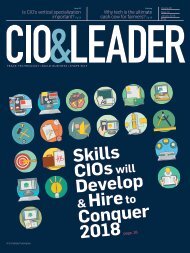CIO & LEADER-Issue-01-April 2018 (1)
Create successful ePaper yourself
Turn your PDF publications into a flip-book with our unique Google optimized e-Paper software.
Cover Story<br />
working in the start-ups that make<br />
them attractive to large enterprises.<br />
<strong>CIO</strong>s are always looking for a fresh<br />
wave of talent among their midst,<br />
which helps them to innovate, to<br />
inspire internal employees, and to<br />
implement a technology product in a<br />
short span of time.<br />
Despite the pressure of digital<br />
transformation and the compelling<br />
need to work with start-ups, large<br />
enterprise <strong>CIO</strong>s need to be certain of<br />
a start-up's intention. Organizations<br />
should be able to gauge that early on<br />
if it is just a marriage by association.<br />
Many a times, a start-up may display<br />
lack of transparency based on past<br />
experiences of having been taken<br />
advantage of, which makes it difficult<br />
for them to accurately assess a startup’s<br />
product or service, and may<br />
ultimately, face rejection.<br />
It is the job of the start-up to<br />
understand the requirements of<br />
the business. Most start-ups are<br />
rejected because of their failure to<br />
present a viable business case for the<br />
organization. In situations like these,<br />
it is the <strong>CIO</strong>'s or the business head's<br />
prerogative to advise and mentor the<br />
start-up in a direction that helps them<br />
to churn out a success story.<br />
All said, a leap<br />
of faith goes a<br />
long way in any<br />
partnership<br />
Like HDFC Bank, many large<br />
organizations host competitions,<br />
hackathons, and events for start-ups<br />
around a particular technology or a<br />
theme. These events provide the<br />
right kind of exposure and the<br />
opportunity to interact, meet faceto-face,<br />
and display maturity that<br />
opens doors to new relationships and<br />
business partnerships.<br />
In the last three years, digital<br />
transformation has been the driving<br />
force for many large organizations to<br />
seek greener pastures for talent, ideas<br />
and technology. As a result, <strong>CIO</strong>s and<br />
their organizations are opening their<br />
doors to innovation and new forms of<br />
collaboration with start-ups.<br />
Companies such as RJ Corp,<br />
Bajaj Auto, HDFC Bank, and ONGC,<br />
are only a few ex<strong>amp</strong>les of large<br />
organizations that are committed to<br />
working with start-ups and in the<br />
last 3-4 years, have kept a consistent<br />
dialogue with the start-ups that they<br />
have worked with in the form of<br />
product upgrades, new business, and<br />
building relationships with them.<br />
Start-ups also should understand<br />
that they must preserve their business<br />
models and stay true their DNA. A<br />
lot of organizations employ the same<br />
tedious assessment process that they<br />
do for other technology partners. As a<br />
result, they expect start-ups to tow the<br />
line and adjust to implementing a little<br />
'extra' on the side. In such cases, startups<br />
must be clear about the business<br />
they are in, and how must they are<br />
willing to accommodate. However, a<br />
lot of start-ups also see this as a form<br />
of additional business opportunity<br />
that will help them mature their<br />
products and make them more<br />
attractive to big customers.<br />
Start-ups have to overcome their<br />
fear of being let down. Many complain<br />
that they are made to work with teams<br />
at large organizations that pose as<br />
innovation centres, and the technology<br />
solution never sees the light of day.<br />
Therefore, organizations and<br />
start-up must clearly define this<br />
We have a total<br />
of 70 clients in<br />
India; Bajaj being<br />
our number one<br />
client with having<br />
deployed 150 so<br />
far. They have been<br />
buying cobots since<br />
2<strong>01</strong>0. Thanks to<br />
them, the top 5 twowheelers<br />
are using<br />
our technology.<br />
Pradeep David,<br />
CTO, Universal Robots<br />
partnership and set up deadlines<br />
for product planning and execution<br />
– even if it means shorter timelines<br />
for a 3-month long technology<br />
implementation. Large organizations<br />
must also appoint people who<br />
understand the start-up ecosystem<br />
and work towards building trust and<br />
creating continuous engagement.<br />
Partnerships demand a lot of time<br />
and investment. Therefore, once you<br />
take the plunge, start-ups and large<br />
enterprises must work together to<br />
sort out their differences at every step<br />
of the way, respect boundaries, and<br />
co-develop innovative new solutions<br />
that better serve their customers – just<br />
like a dream team playing to win<br />
<strong>April</strong> 2<strong>01</strong>8 | <strong>CIO</strong>&<strong>LEADER</strong><br />
19














